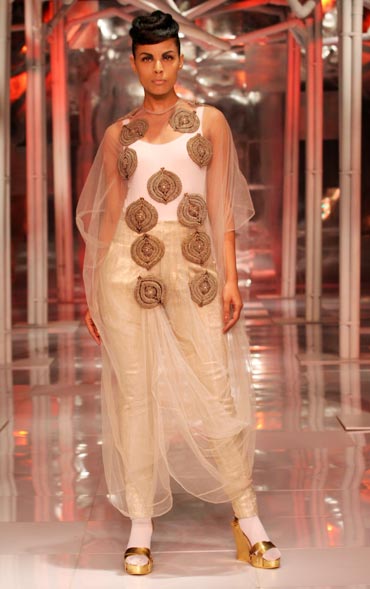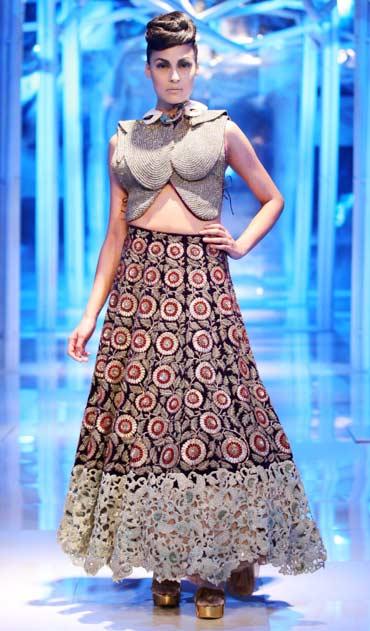Yohji Yamamoto is fed up with casual. He wants men to dress up, not down. "I think current fashion is too American. It's T-shirts and shorts all the time. I think we need some proper elegance to enhance the atmosphere a bit." With that in mind, the designer sent out a collection of eccentric exaggerations—one might call them arty caricatures—of menswear's gloriously dressy past, specifically the eighteenth century.
The result looked like Mozart and his friends on acid. Elongated jackets were given random bits of cross-stitch sampling, and rich English florals, echoing great-great grandma's upholstery, showed up in loose suits. Yamamoto morphed shirts and vests into curvy hourglass tunics in a patchwork of knits and wovens. Midway through the show, the models began to resemble Eustace Tilley,The New Yorker's dandy mascot, in cutaway jackets. Then he switched to more abstract tailoring all in slate blue, lavender, or orange, complete with matching stiff shirts, shoes, and socks.
By the end of the show, Yamamoto had come up with pilgrim peaked hats and powdered wigs, asymmetrical collars—one side pointing upward, the other down—and George Washington curly 'dos, one male hairstyle that's not ready for a comeback.
Thursday, September 30, 2010
Tuesday, September 21, 2010
ANAMIKA KHANNA and her collections
away from the traditional demure bridal wear designs, designer Anamika Khanna's bridal collection was all about sharp cuts and smart silhouettes. While traditional colours such as gold were used aplenty, Khanna also dared to experiment with black like in this design alongside.

Photographs: Courtesy R&P: Edelman





Netted leggings and an asymmetrical bottom in black contrasts the well-defined top in white. Yet again not the traditional colours (or silhouettes) for an Indian bride.
Feminism is prevalent even though the silhouettes are fluid yet bold. Silhouettes showcased broad pants, skinny leggings, short jacket, summer coat and blazer. Dresses were seen taking many forms, mainly transforming into slip dress, coat dress, wrap dress besides the evergreen shift dress.
The ensemble was embodied with layers, pin tucks, cutouts, handcrafted appliqus and zardozi, crushed chiffons, organza, and nets. The collection showed handcrafted elements of Zarikota gold, print and beaten zardozi, and deconstruction and distortion of every beautiful embroidery.
The sarees were in solid colours with sheer imparting a glamorous persona. A touch of copper border added the sheen. Muslins, chiffons and summer silks were crumpled in every form. Khanna has used calico prints in her collection
Woodblock printing is a technique for printing text, images or patterns used widely throughout East Asia and originating in China in antiquity as a method of printing on textiles and later paper.
As a method of printing on cloth, the earliest surviving examples from China date to before 220, and from Egypt to the 4th century.
Ukiyo-e is the best known type of Japanese woodblock art print. Most European uses of the technique on paper are covered by the art term woodcut, except for the block-books produced mainly in the 15th century.
Hand Block Printing

Block printing is believed to have originated in China towards early 3rd century. Records of its presence in Egypt and some Asian countries were also found around the 4th century, from where it spread to Europe and other places. Apart from wood, blocks were made of metals and porcelain also. But wooden block remains the most sought after apart from metal ones which has gained popularity in recent times. In hand block printing, the design is first drawn on wood using a sharp needle and then the desired design is carved using the chisel, hammer, file, nails etc. The printing involves laying the cloth/fabric, which is to be printed, on flat tables and impressions are made using the beautifully carved blocks. In case of direct printing, the block is dipped in the colored dye and impressions are made. In case of resist dyeing, impression of an impermeable material (clay, resin, wax etc) is made on the fabric which is then dyed in the desired shade. The block image remains un printed and reappears in reverse. Traditionally natural and vegetable sources were used for dyes. But with the advent of synthetic dyes, things have changed, not necessarily for good. The ease of usage and the availability of synthetic dyes have replaced the vegetable dye in many cases.
Since 12th century India has patronized the art of Hand Block printing on different fabrics. The artistry flourished further with the receivable of royal patronage. Rajasthan and Surat in Gujarat became the important trading centers of printed textiles particular in Block Print art. Today Block Printing has gained new height by reaching in the different corners of the world. The artisans try hard on developing the art completely through natural means using vegetable dyes and natural colors for printing and preserving their workmanship by passing it over to the coming generations.
One will see the use of blue, yellow, red and saffron color the most. There is also much diversity in design, normally varying from figures of animals and birds to traditional patterns of flowers, trees and also modern graphical patterns. These magnificent block prints and designs are best used in decorative wall hangings, garments like saris, skirts, tops, bed linens and dress


One will see the use of blue, yellow, red and saffron color the most. There is also much diversity in design, normally varying from figures of animals and birds to traditional patterns of flowers, trees and also modern graphical patterns. These magnificent block prints and designs are best used in decorative wall hangings, garments like saris, skirts, tops, bed linens and dress



Miss Universe 2010
 Miss Universe 2010, the 59th edition of the pageant, was held at the Mandalay Bay Events Center in the Mandalay Bay Resort and Casino, Las Vegas, Nevada, U.S. on August 23, 2010. It was hosted by Bret Michaels and Natalie Morales. Ximena Navarrete, Miss Mexico, was crowned Miss Universe 2010 by outgoing titleholder Stefania Fernandez from Venezuela
Miss Universe 2010, the 59th edition of the pageant, was held at the Mandalay Bay Events Center in the Mandalay Bay Resort and Casino, Las Vegas, Nevada, U.S. on August 23, 2010. It was hosted by Bret Michaels and Natalie Morales. Ximena Navarrete, Miss Mexico, was crowned Miss Universe 2010 by outgoing titleholder Stefania Fernandez from VenezuelaMonday, September 20, 2010
Subscribe to:
Comments (Atom)


























